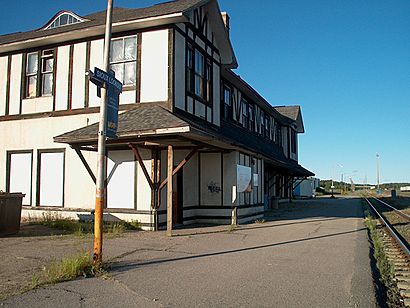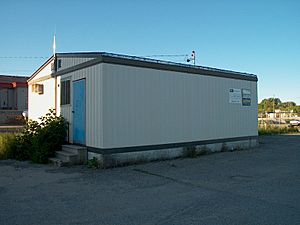Sioux Lookout station facts for kids
Quick facts for kids
Sioux Lookout
|
|||||||||||
|---|---|---|---|---|---|---|---|---|---|---|---|
 |
|||||||||||
| Location | 53 Front Street Sioux Lookout, Ontario Canada |
||||||||||
| Coordinates | 50°05′51″N 91°54′58″W / 50.09750°N 91.91611°W | ||||||||||
| Owned by | Via Rail | ||||||||||
| Construction | |||||||||||
| Disabled access | Yes | ||||||||||
| History | |||||||||||
| Opened | 1911 | ||||||||||
| Services | |||||||||||
|
|||||||||||
|
Heritage Railway Station (Canada)
|
|||||||||||
| Official name: CNR/VIA Rail Station | |||||||||||
| Designated: | 1993 | ||||||||||
| Reference #: | 6906 | ||||||||||
The Sioux Lookout railway station is a train station in the town of Sioux Lookout, Ontario, Canada. It is an important stop for trains traveling across Canada. The station is part of the Canadian National Railway's main line, which stretches across the country. It is used by Via Rail and serves the Canadian train, a famous transcontinental passenger service.
Contents
About the Sioux Lookout Train Station
The Sioux Lookout railway station is a key spot for train travel in northwestern Ontario. It connects people and goods across Canada. The station helps travelers reach different parts of the country. It also plays a role in the local community of Sioux Lookout.
Where is Sioux Lookout Station?
This station is located at 53 Front Street in the town of Sioux Lookout. Sioux Lookout is a town in the Kenora District of Ontario. It is known for its beautiful lakes and forests. The station's location makes it a central point for the area.
What Trains Use This Station?
The Sioux Lookout station is mainly used by Via Rail. Via Rail is Canada's national passenger train service. The most well-known train that stops here is the Canadian. This train travels all the way across Canada. It connects major cities like Toronto and Vancouver. The station is also on the Canadian National Railway's main line. This line is a very important route for freight trains.
The Famous Canadian Train
The Canadian train is a long-distance passenger service. It offers a unique way to see Canada's landscapes. Travelers can enjoy views of mountains, prairies, and forests. The train has different types of cars. These include sleeping cars, dining cars, and observation cars. Stopping at Sioux Lookout allows passengers to get on or off. It also lets the train crew change shifts.
History of the Station
The Sioux Lookout railway station has a long history. It first opened its doors in 1911. This was a time when railways were growing fast in Canada. They were essential for connecting communities. Railways helped move people and goods across vast distances.
A Heritage Railway Station
In 1993, the Sioux Lookout station was recognized as a heritage railway station. This means it is an important historical building. It shows how railway stations used to look and function. The station's design and age make it special. It helps us remember the past of Canadian rail travel.
Why is it a Heritage Site?
Being a heritage site means the station has historical value. It represents a part of Canada's transportation history. These stations are often preserved. This helps future generations learn about them. The station's architecture and its role in the community are key reasons for its designation.
Services at the Station
The Sioux Lookout station offers various services for travelers. These services help make train journeys comfortable. While it is not a large station, it provides essential amenities.
Passenger Amenities
Travelers can find basic services at the station. These might include a waiting area. There could also be information about train schedules. The station is designed to be accessible. This means it can be used by people with disabilities. This is important for making travel fair for everyone.
Connecting to Other Places
The station connects Sioux Lookout to other towns and cities. The next stops on the Canadian train line are Richan to the east and Savant Lake to the west. This shows how the station is part of a larger network. It helps people travel between different regions.


